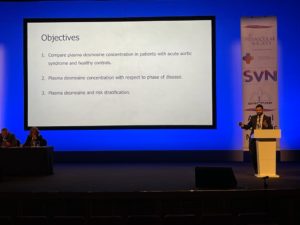
Research indicates that plasma desmosine has the potential to act as a biomarker of acute aortic syndrome and could, in the future, be used as a diagnostic tool for the condition in the acute setting.
Presenting the findings of a British Heart Foundation-funded study during the Sol Cohen Prize Session at the UK Vascular Societies’ Annual Scientific Meeting (VSASM 2021) held Dec. 1–3, in Manchester, England, Maaz Syed, a medical student at the University of Edinburgh, Edinburgh, Scotland, concluded that a multicenter, collaborative effort is needed to propel future investigation. The British Heart Foundation-funded study, published as an abstract in Heart, was a collaborative effort between the University of Edinburgh and Anna Maria Choy, MBBS, and her team at the University of Dundee, Dundee, Scotland.
Acute aortic syndrome “poses challenges in diagnosis, is unpredictable and is catastrophic,” Syed told the VSASM audience. It is known that patients with abdominal aortic aneurysms (AAAs) have raised desmosine, but, according to Syed, it has never been tested in patients with acute aortic syndrome before. Therefore, the research team set out to compare plasma desmosine concentrations in patients with acute aortic syndrome compared to healthy controls, with the primary aim of determining whether desmosine concentrations change with respect to phase of disease.
The investigators analyzed plasma desmosine concentrations in 53 patients with acute aortic syndrome and compared them to 106 controls, Syed relayed. The presenter noted that the groups were “reasonably well matched,” although patients in the acute aortic syndrome group were slightly older on average, more likely to be male and had lower blood pressures than the patients in the control group as they were on antihypertensive therapy.
“As we had hypothesized, plasma desmosine concentration was increased in patients with acute aortic syndrome compared to controls,” the presenter informed VSASM attendees. He added that this was true across all three sub-pathologies: aortic dissections, intramural hematomas and penetrating aortic ulcers.
The researchers were mainly interested in phase of disease, Syed detailed, noting that the majority of patients the team recruited belonged to the acute, subacute and chronic groups. The team started noticing a trend: “It looked like the closer you got to the event, the higher the plasma desmosine we observed.”
In light of this finding, Syed and colleagues then collected blood from the three patients who had presented with chest pain and later gone on to develop acute aortic syndrome or be diagnosed with acute aortic syndrome. “We thought that their plasma desmosine would be higher, but we were not expecting to see such a high level,” he remarked.
The team developed a simple linear regression model to check that it was not a change in baseline demographics that was influencing the levels of plasma desmosine. “Plasma desmosine presentation had a three-fold increase compared to 106 healthy controls independent of their age, their sex and their smoking status, and this was statistically significant,” he explained.
The presenter detailed that, while the phase of disease helps clinicians work out morphologically how the aorta is going to behave, it does not necessarily reflect the pathobiological properties of the aorta with respect to time. Therefore, the team also wanted to see how plasma desmosine concentrations differed with respect to time as a continuous variable. One of their key findings was that plasma desmosine level peaked at presentation and gradually decreased with respect to time, but that even patients who are many years out of the initial event had a raised desmosine level.
Finally, Syed and colleagues wanted to determine if plasma desmosine can influence the prediction of longitudinal outcomes. They developed another linear regression model, this time fitting aortic growth against desmosine and conventional clinical predictors. “Desmosine outperformed things like aortic diameter and the age of the dissection or the intramural haematoma,” he reported.
A possible diagnostic tool
“We have demonstrated not only that plasma desmosine is increased in patients with acute aortic syndrome, but that it is detectable within 24 hours of symptom onset,” Syed summarized, stressing that this has implications for the use of plasma desmosine as a potential diagnostic tool in the emergency department. Plasma desmosine also appears to be associated with aortic expansion independent of things like aortic diameter, the presenter added.
Discussion following Syed’s presentation delved further into the findings, with Richard Gibbs, MBChB, a consultant vascular surgeon at Imperial College Healthcare NHS Trust, London, England, keen to know if the researchers had data on plasma desmosine levels in patients with connective tissue disorders. Syed noted that in the one patient they assessed who had Marfan syndrome, the team noticed a five- to six-fold increase in his plasma desmosine. Two weeks later, the patient developed a dissection. “It is very hard to capture something like this, we were lucky,” the presenter commented, “but it was findings such as this that made us think maybe this is an important biomarker in patients with acute aortic syndrome, and we are now systematically testing plasma desmosine in patients with connective tissue disorders for that reason.”
Closing his presentation, Syed was keen to emphasize the importance of the research. He explained that when the findings were published earlier this year, the team was approached by the Aortic Dissection Charitable Trust. “The trust was set up in 2015 by a group of MPs who had sadly experienced loss of life in young members of their families due to this catastrophic disease, and one of the benefits of presenting research such as this in this forum is that we can gauge interest among the vascular community in developing a biomarker to diagnose acute aortic syndrome and improve risk stratification.” He continued: “Clearly, work needs to be done to take this forward, and that is going to require a multicenter, collaborative effort.”












